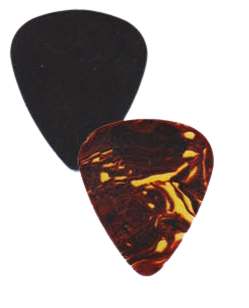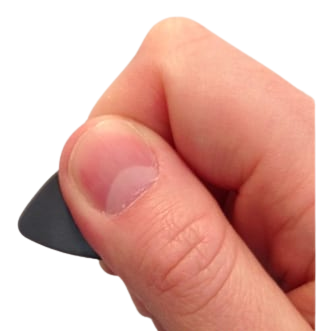How to Choose Guitar Picks: A Comprehensive Guide. As a guitarist, you know that choosing the right guitar pick is essential to achieving the sound you want.
With so many different types of guitar picks available, it can be overwhelming to choose the right one. Luckily, there are a few key factors to consider when selecting a guitar pick that will help you find the perfect one for your playing style.
Table of Contents
Hi. Ian here and welcome to this article on How to Choose Guitar Picks.

Guitar picks are an essential tool for any guitarist, whether you’re a beginner or a seasoned pro. They come in a variety of shapes, sizes, and materials, and each type of pick can produce a different sound and feel. So how do you choose the right pick for you?
Here are a few things to consider:
Thickness: Guitar pick thickness is measured in millimetres (mm). Generally, thinner picks are more flexible and easier to strum with, while thicker picks are more rigid and produce a brighter, more aggressive sound.
Material: Guitar picks are made from a variety of materials, including plastic, celluloid, metal, and even wood. Each material has its unique properties that affect the sound and feel of the pick. For example, plastic picks are the most common type of pick and produce a well-rounded sound. Celluloid picks are similar to plastic picks, but they have a warmer, more mellow tone. Metal picks produce a brighter, more aggressive sound, while wooden picks produce a softer, more natural sound.
Shape: Guitar picks come in a variety of shapes, but the most common shape is the teardrop pick. Teardrop picks are easy to hold and control, making them a good choice for beginners and experienced players alike. Other popular pick shapes include jazz picks, triangle picks, and thumb picks.
Genre: The type of music you play can also influence your pick choice. For example, if you play rock or metal, you may prefer a thicker pick that will produce a brighter, more aggressive sound. If you play folk or country, you may prefer a thinner pick that will produce a softer, more mellow sound.
Personal preference: Ultimately, the best way to choose a guitar pick is to experiment and find what feels and sounds best to you. There is no right or wrong answer, so try out different picks and see what you like best. Over the years I have tried every thickness and size of pick before I settled on a type I was happy with.
Here are a few tips for choosing guitar picks:
- Start with a medium-thickness pick. This is a good all-around pick that is versatile enough for a variety of genres.
- Experiment with different materials to see what you like best. Each material has its own unique sound and feel.
- Try out different pick shapes to see what is most comfortable for you to hold and control.
- Consider the type of music you play when choosing a pick. If you play rock or metal, you may prefer a thicker pick that will produce a brighter, more aggressive sound. If you play folk or country, you may prefer a thinner pick that will produce a softer, more mellow sound.
- Don’t be afraid to experiment. There is no right or wrong answer when it comes to choosing a guitar pick. Try out different picks and see what feels and sounds best to you.
Here are a few resources where you can learn more about guitar picks:
- Ernie Ball Guitar Picks Guide: https://www.ernieball.com/guitar-accessories/guitar-picks
- Sweetwater Guitar Pick Guide: https://www.sweetwater.com/c929–Guitar_Picks
- Guitar World Guitar Pick Guide: https://www.guitarworld.com/tag/picks
Choosing the right guitar pick is an important part of any guitarist’s journey. By considering the factors above, you can find the pick that is perfect for you and your playing style. So don’t be afraid to experiment and try out different picks until you find the one that you love.
So, firstly, you need to consider the thickness of the guitar pick. Thin picks are typically used for strumming and producing a brighter sound, while thicker picks are better for producing a warmer, fuller sound. Medium picks are a good all-around choice for most playing styles. Additionally, the shape of the pick can affect your playing experience.
Some guitarists prefer a standard teardrop shape, while others prefer a more unique shape that provides a better grip. Finally, the material of the pick can also affect your playing experience. Different materials produce different sounds and have different levels of durability.
Understanding Guitar Picks

Guitar picks, also known as plectrums, are small, flat, and triangular-shaped tools used to pluck the strings of a guitar. They come in a variety of materials, shapes, and sizes, making it important to choose the right one for your playing style and skill level.
Should Beginner Guitar Players Use a Pick?
While it is possible to play the guitar without a pick, using one can help beginners achieve a more consistent and cleaner sound. Picks can also help with speed and accuracy, making it easier to play complex riffs and solos.
Are Thin Picks Better for Beginners?
Thin picks are generally easier to use for beginners as they require less force to pluck the strings. They also produce a softer and more mellow sound, which can be ideal for playing rhythm guitar. However, as you progress and develop your playing style, you may find that thicker picks offer more control and precision.
When choosing a guitar pick, consider the following factors:
- Thickness: Picks come in various thicknesses, ranging from thin (0.38mm) to extra heavy (1.5mm). Thicker picks are generally more durable and offer more control, while thinner picks are more flexible and produce a softer sound.
- Material: Picks can be made from a variety of materials, including plastic, nylon, celluloid, and metal. Each material has its unique sound and feel, so it’s worth trying out a few different options to see which one suits you best.
- Shape: Picks come in a range of shapes, including standard, jazz, and teardrop. The shape you choose can affect your playing style and the sound you produce.
- Texture: Some picks have a textured surface to provide a better grip, while others are smooth. The texture you choose can affect your ability to hold the pick securely and play with precision.
In conclusion, choosing the right guitar pick is an important part of achieving the sound and playing style you desire. Experiment with different picks to find the one that feels most comfortable and produces the sound you’re looking for.
Choosing the Right Guitar Pick
When it comes to playing guitar, choosing the right pick can make a significant difference in your playing experience. With so many options available, it can be overwhelming to decide which pick is best for you. In this section, we will explore some considerations for beginners and picks for strumming to help you choose the right guitar pick.
Considerations for Beginners
If you are just starting out playing guitar, it’s important to choose a pick that is comfortable and easy to hold. Consider picks that are:
- Lightweight: A lightweight pick will help you develop your playing technique without getting tired too quickly.
- Medium thickness: A medium-thickness pick is a good place to start for beginners. It provides enough rigidity to play chords and enough flexibility to play lead lines.
- Standard shape: A standard-shaped pick is the most common and versatile option. It allows you to play different styles of music and techniques.
Picks for Strumming
If you are primarily a strummer, you’ll want to choose a pick that produces a warm and full sound. Consider picks that are:
- Medium to heavy thickness: A thicker pick will produce a fuller sound when strumming chords.
- Rounded edge: A rounded edge pick will help you produce a smooth and warm sound when strumming.
- Celluloid material: Celluloid picks are a popular choice for strumming because they produce a warm and full sound.
It’s important to note that the right pick for you ultimately depends on your playing style and personal preference. Experiment with different picks to find the one that feels best in your hand and produces the sound you want.
How to Hold a Guitar Pick
The Basic Grip
The basic grip for holding a guitar pick involves holding the pick between your thumb and index finger. Your thumb should be on top of the pick, and your index finger should be underneath it. The pick should be positioned so that the pointed end is sticking out away from your hand.

Holding a guitar pick might seem like a simple task, but it’s an essential part of playing the guitar. The way you hold your pick can affect your tone, speed, and accuracy. So, it’s important to learn how to hold a guitar pick properly.
To get started, place the pick between your thumb and index finger. Make sure that the pick is positioned correctly, with the pointed end sticking out. Then, close your fingers around the pick, making sure that you have a relaxed grip.
Experiment with Different Angles
One thing to keep in mind is that the angle at which you hold your pick can affect your tone. Experiment with different angles to see what sounds best to you.
Some guitarists prefer to hold their pick at a slight angle, while others prefer to hold it straight. You can also experiment with holding the pick closer to the pointed end or closer to the rounded end.
Find What Works for You
Ultimately, the way you hold your guitar pick is a matter of personal preference. There’s no one “right” way to do it. Some guitarists prefer a loose grip, while others prefer a tighter grip.
The most important thing is to find a grip that feels comfortable and allows you to play with speed and accuracy. It may take some experimentation to find the right grip for you, but it’s worth the effort.
Conclusion
In summary, holding a guitar pick is an essential part of playing the guitar. The basic grip involves holding the pick between your thumb and index finger with a relaxed grip. Experimenting with different angles and finding what works for you is key to developing your unique sound.
Frequently Asked Questions
What is the best pick thickness for an electric guitar?
The best pick thickness for an electric guitar depends on your playing style and personal preference. Generally, thinner picks (around 0.5-0.7mm) are better for strumming and rhythm playing, while thicker picks (around 1.0-1.5mm) are better for lead playing and heavy strumming.
What is the best pick thickness for an acoustic guitar?
The best pick thickness for an acoustic guitar also depends on your playing style and personal preference. Generally, thinner picks (around 0.5-0.7mm) are better for strumming and rhythm playing, while thicker picks (around 1.0-1.5mm) are better for lead playing and heavy strumming.
What are the best guitar picks?
The best guitar picks are subjective and depend on your playing style and personal preference. Some popular options include Dunlop Tortex, Fender Mediums, and Ernie Ball Prodigy picks.
What size are guitar picks in cm?
Guitar picks are typically measured in millimetres (mm), not centimetres (cm). The most common sizes range from 0.5mm to 2mm.
What is the best pick thickness for playing metal on a guitar?
For playing metal on a guitar, thicker picks (around 1.5-2.0mm) are generally recommended. This is because they provide more control and precision for fast picking and shredding.
Which brand of guitar picks do most professional guitarists use?
Most professional guitarists use a variety of brands and types of guitar picks depending on their playing style and the sound they are trying to achieve. Some popular brands include Dunlop, Fender, and Ernie Ball.
Conclusion
Choosing the right guitar pick is crucial for your playing style and sound. It can be overwhelming to navigate the various thicknesses, shapes, and materials available. However, with a little knowledge and experimentation, you can find the perfect pick for you.
Remember, the thickness of the pick affects both your tone and playing style. Thin picks are ideal for strumming and rhythm guitar, while heavy picks are better suited for lead guitar and heavy rock. Medium picks are a good compromise between the two.
The shape of the pick can also affect your playing. Standard picks with a teardrop shape are versatile and suitable for most playing styles. However, if you prefer a more precise attack, a pointed pick may be more suitable. Jazz picks have a smaller, more rounded shape and are ideal for jazz and blues guitar.
Material is another important factor to consider. Plastic picks are the most common and affordable option. However, if you prefer a warmer tone, consider a pick made of wood or bone. Metal picks can also provide a unique sound but may require some adjustment to your playing style.
Ultimately, the best way to choose a guitar pick is to try out different options and see what feels and sounds best for you. Don’t be afraid to experiment and try something new. With a little patience and practice, you’ll find the perfect pick to elevate your playing to the next level.
